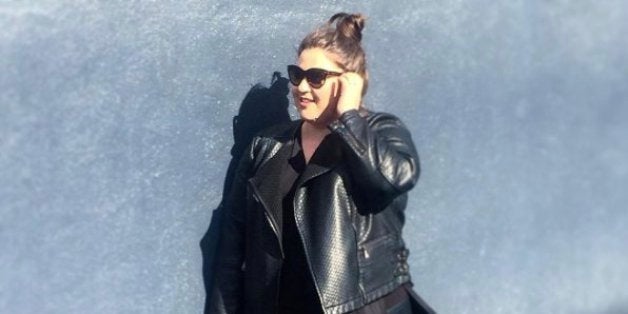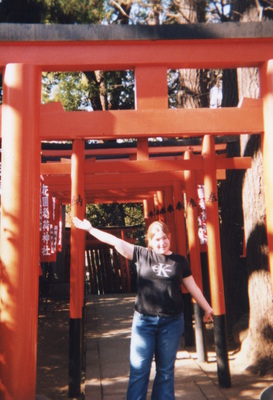
"Photographs are evidences not only of what's there, but of what an individual sees. Not just a record, but an evaluation of the world." -- Susan Sontag (1977) on photography
When I began my education as a photography student, I knew that I loved fashion. I knew that I wanted to make the type of inspiring images I was seeing in the most influential fashion magazines. But I didn't know, how my personal experiences would shape my work as a photographer.
Moving through my education, I understood that fashion models looked "a certain way". I understood that if I wanted to "make it," I would have to shoot a specific-sized woman (read: size 0-2). Another body type didn't feel like an option. In the beginning, I didn't care. The fashion world in New York City felt so far from my own reality -- it was the type of elite creativity I wanted to be a part of.
I hadn't stopped to consider how viewing images from this elite collective impacted my development and self-image as an adult.
I spent the majority of my childhood years living abroad on various military bases. I remember being nine years old, cutting out models from my mom's Victoria's Secret catalogs. I idolized their bodies, and couldn't wait for the day I would look like that.
You can imagine my disappointment when that day never came.
I was 13 years old when I first started dieting. I was already wearing a women's size 14, and wanted to shrink down to look like Liv Tyler in Empire Records. The Atkins diet was the current craze, and I was committed to eliminating carbs. Have you ever tried to cut carbs from a middle school cafeteria menu? The attempt was anything but successful.
As a result, I felt afraid to eat in front of people. I thought everyone was watching and judging me. I thought that if I ate healthy, people would think I was trying to lose weight--and vice versa. At school I made sure never to finish what was on my plate, and would save food items so I could eat them later in private.
14 with a friend's cheerleading outfit. They didn't come in larger sizes, so I had to hold it up for the photo.
I believed that people couldn't see past my body. I felt confined to being the fat girl, the funny girl, never just... Anastasia. I used to think if I dressed cool enough, listened to cool music, was funny... maybe no one would notice I was fat. I used to think, if I could just be thin... be normal. Then, everything would be better. I believed my weight held me back from all the "normal" experiences I desperately wanted to have.
I was 15 when I bent down during lunch and ripped my Calvin Klein jeans straight down the ass.
"You wear those jeans like everyday?" my "friends" joked. I was humiliated. I felt embarrassed for my limited wardrobe. My friends didn't know they weren't the same jeans. They were just the only jeans that fit, so I bought three pair. My middle school years were spent on an isolated military base in Northern Japan, where the options for curvy teenagers were basically nonexistent.
Me and the Calvin Klein jeans, 15 years old, Japan
My senior year, I was back in the US, and all I wanted was to look like Carrie Bradshaw at my senior prom. On a trip to New York with my parents, we stopped at a custom dress store in the garment district. I chose a pattern for a perfect custom Bradshaw-inspired gown. When the dress arrived, it fit me like a paper bag with a train. The color was terrible, and it felt like a Quinceañera dress from hell.
I spent the next few weeks looking for a replacement that would give me the sense of confidence I wanted to feel at my senior prom. But there wasn't a single store in my hometown that carried a prom dress in my size. I still remember the disappointment and frustration I felt. For my friends, shopping for prom was the culmination of the high school girl's experience. I remember going with them, feeling jealous and sad as they tried on dress after dress that fit them perfectly.
After weeks of searching, I felt defeated. I had no choice but to wear the Quinceañera dress and pretend to not to look embarrassed in the photos next to my date.
A few years later, I would get my first opportunity to change this narrative. Plus size photography fell into my lap when the internet fashion company I worked for announced "a new category" would be launching: "The Plus Size Store".
It was incredible to glance around the conference room and watch my co-workers blankly look around. All seasoned professionals who were unsure of what "plus size" meant, let alone how to approach it. I remember the early conversations around model bookings, when it was suggested we should shoot the clothing on regular sized models and pin the clothes to fit. Repulsed by this idea, I unintentionally exploded in a meeting.
"No! You HAVE to use plus size models."
Like something straight out of a movie, the room was quiet, and everyone turned to look at me (a then 22-year-old kid, fresh out of art school). I continued:
"The plus size customer cannot get a real sense of fit and silhouette if you're showing it on regular sized fashion model. The clothes won't sell, it's an insult to the customer".
My boss silently stared at me, and I expected him to dismiss my comments as naïve ranting. But instead, he listened. Everyone listened. They inherently trusted what I had to say, because I--unlike them--was a plus size woman.
That day, I was assigned the biggest project I'd ever had. I was asked to help lead the brand launch, present model casting options, and shoot all product and editorial imagery for the site launch.
This project began to change my perspective. I realized that with my position in the world of e-commerce I was seated with the decision makers, and became a decision maker. This position has allowed me to raise the question I knew so many women had: Why are you excluding me? For the first time my personal experiences shaped my career path.
I began to understand that as a photographer, I have influence over the standard of beauty; the power to influence change on a visual level.
This realization was the beginning of a choice I would make. The choice that as a photographer, I would use my position to create diverse and inclusive images. Images that would serve the women viewing them, instead of damaging them.
It's my responsibility to be conscious about the images I create and to be mindful of their impact on the people viewing them.
And, it's working. I am seeing results from the work so many of us have done. By declaring: "We are here, and we're not leaving", we've given so many women the strength to express the trials of chasing an ideal that is unhealthy in so many ways. We are beginning to move portions of the goliath fashion industry to execute a more inclusive representation of beauty. It's refreshing that they are realizing what we've known for years: there are billions of dollars to be made. All retailers have to do is embrace, instead of marginalize. The truth is, shifting the conversation IS profitable.
The momentum in the industry is exciting... but there is still work to be done. There has been sudden growth in a relatively short amount of time, but still only a small portion of retailers and publications are willing to embrace the message of inclusivity. The media is discussing model choices and language use, but needs to consider the systemic thinking as a whole. How we address that, remains to be seen.
What is plain to see is how much power consumers truly have. If you find yourself frustrated with the lack of representation, and clothing options...Remember: you are in control. Your spending power makes you the real driver in the decisions companies make. You are the business and have the power to execute change.
Change is coming.
It's taken me 28 years to understand that I am not flawed. I've come to realize that paradigms in our society groomed me to believe that I was abnormal and undesirable. But I'm happy to say that is no longer my truth. I've come to a place where being "plus size" doesn't make me feel defeated. Now, my goals revolve less around looking like a Victoria Secret model and more around creating images that celebrate women in all shapes, sizes, and ethnicities. My journey hasn't been easy but I am proud to be plus size. I am proud to acknowledge that my waistline doesn't define me (at least, not negatively). I'm proud that when I look in the mirror and see every round piece, every giggly part I see the soft shell that protects the most beautiful part of me: the part that's a lover, a fighter, a kind hearted, fire-spirited woman; a woman who has a made a choice to use her passion as way to help broaden the conversation.





